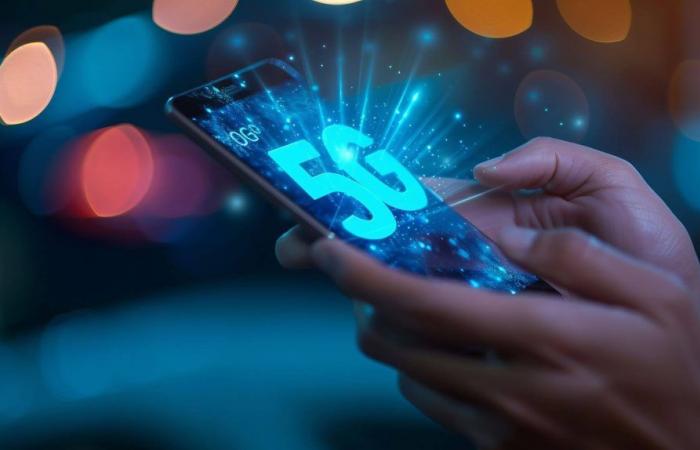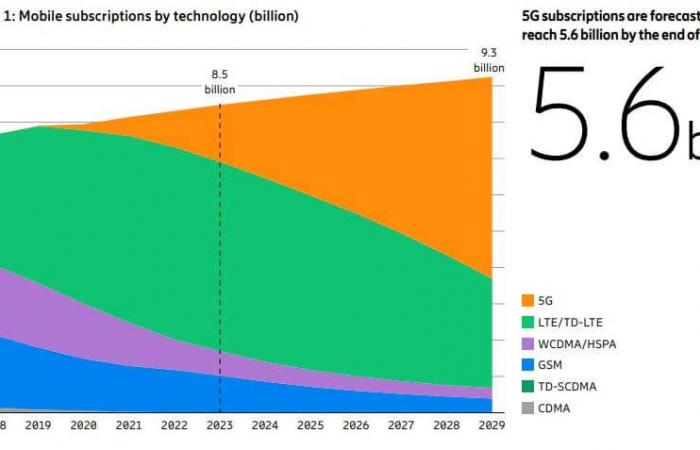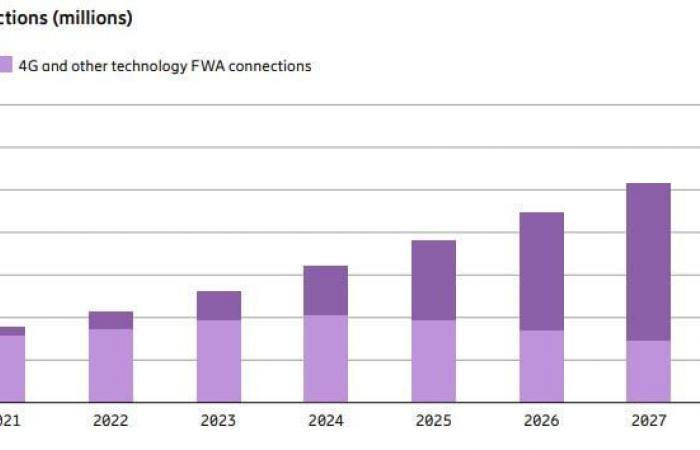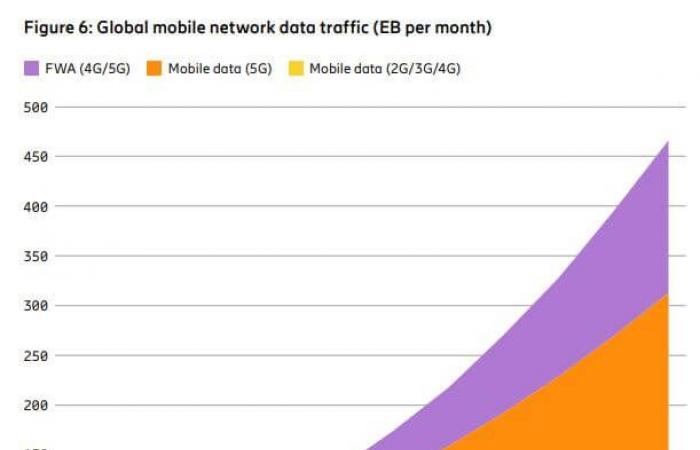He 5G deployment continues to grow at such a rate that subscriptions to this technology in the world are expected to reach 5.6 billion by the end of 2029. This is confirmed by the last Ericsson Mobility Report corresponding to the month of June.
During the first quarter of 2024, 160 million 5G subscriptions were added to exceed a total of 1.7 billion. This advance predicts that the fifth generation of mobile networks will become the dominant mobile access technology by subscription before the end of the forecast period. Although 5G population coverage is growing, 5G mid-band is only deployed in about 25% of all locations in the world outside of mainland China. 5G mid-band spectrum provides a sweet spot between both coverage and capacity, while improving the user experience.
Around 300 operators worldwide already offer 5G services, of which around 50 have launched 5G Standalone (5G SA)
The document indicates that, in some markets, service providers are beginning to use the capabilities provided by autonomous 5G offering differentiated connectivity services. In this regard, it specifies that high-performance programmable networks, which use the SA architecture, provide new opportunities for service innovation and performance-based business models.
Analyzed the 5G progress by regions, we can say that its adoption has increased throughout the world. However, North America recorded subscription penetration in this technology of 59% by the end of 2023, while in India it was 10%. Already in the first quarter, both the US and Canada have made progress in rolling out 5G across the country, despite differences in the spectrum bands used. In addition, it is expected that by the end of 2029 North America will have the highest implementation with 90% (or 430 million).
The increase in 5G subscriptions during 2023 in Western Europe was significant
In the case of Western Europe and although penetration lags other developed markets, subscription growth was significant during 2023, going from 72 million in 2022 to 143 million in end of last year. This is equivalent to a penetration of 26% for the region, however, it varies between countries. Markets like United Kingdom and Finlandwhich launched 5G earlier have already reached a high penetration in relation to other enclaves.
The decline of 4G favor the substantial increase in 5G subscribers in the future.
By 2029, 5G subscriptions are predicted to reach around 480 million, representing a penetration of 86%.
FWA Rise
As noted in previous editions, the Fixed Wireless Access (FWA) It is going from strength to strength and the Ericsson report highlights it. But this boost to this technology is given by 5G networks.


Of the CSPs included in the Ericsson study sample (310 worldwide), 241 offered FWA services as of April 2024. Of these, 128, around 53%, included a 5G FWA offer. This represents an increase of twelve points compared to the same period in 2023, that is, a growth of 29%.
In this sense, the number of providers of these services with offers of speed based rates has increased to 40% compared to 27% a year ago.
Currently, FWA is the second use case of 5G after the Enhanced Mobile Broadband (eMBB).
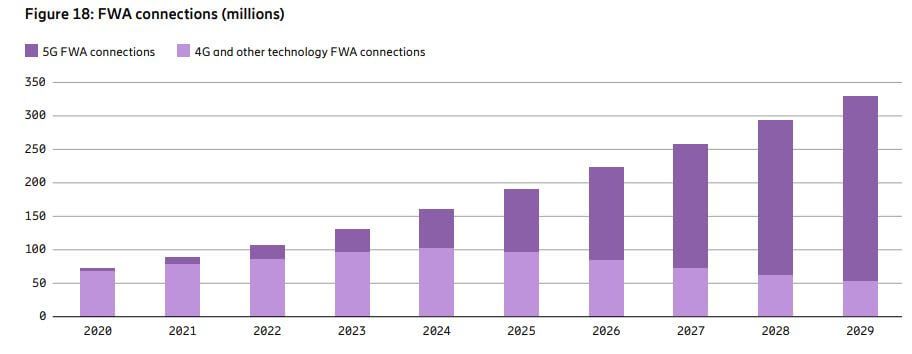

Mobile data traffic growing
The document also indicates that the mobile data traffic It grew by 25% between the first quarter of 2023 and the first quarter of 2024 and will increase by around 20% annually until 2029. In fact, it points out that 5G will represent around 75% of this traffic.
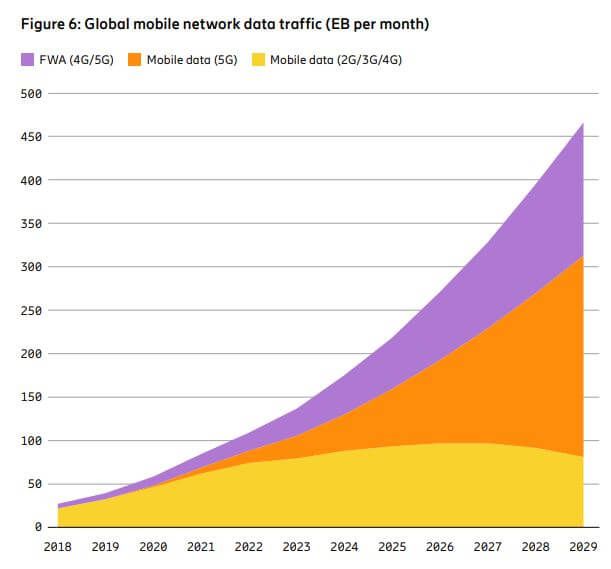

Not in vain, the migration of subscribers to mobile technologies is one of the factors driving traffic growth.
Timid start of the middle band
Another aspect included in the report concerns the middle band. According to the text, mid-band population coverage outside mainland China has reached 35%. It has been the North American and Indian regions that have made rapid deployments, achieving mid-band coverage of 85 and 90%, respectively.
In addition, it states that users of smartphones connected to the 5G mid-band enjoy Faster content loading times and a better user experience in general.
The smartphone market recovers
Chipsets with generative AI (GenAI) capabilities, as well as phones that can process AI without connecting to a server (on-device AI) have entered the market. These devices could shape new user behaviors and change the way we consume applications and services in the future. And they will be a big driver for the struggling smartphone market.
Site Energy Orchestration
Ericsson has also introduced a new solution for the Smart use of energy in telecommunications networks. Is about Site Energy Orchestration and acts as an intelligent bridge between the radio access network (RAN) and electrical networks, optimizing operations to increase energy cost savings, reduce carbon footprint and open new revenue streams.
This solution uses machine learning and AI-powered RAN applications (rApps), RAN data, and external data interconnection. Thanks to these qualities, it allows service providers cluster and orchestrate networks like a virtual power plantwhich makes it possible for operators to participate in public service plans in different markets.
Besides, intelligently optimizes daily energy consumption patterns of telephone networks to avoid spikes in bills, channeling energy only when and where it is needed. This optimizes operations, reducing costs, including energy bills, and unlocks potential revenue from new sources such as energy trading markets.
- Regarding the income flow: Frequency balance. The frequency contention reserve function involves the pooling of many telephone points and their energy storage to disconnect or connect to power grids intermittently to participate in power companies’ bidding plans or processes.
- Regarding the reduction of OPEX (energy costs): Response to the demand. Load shifting and peak shaving functions bundle many mobile networks and their energy storage to disconnect from or connect to power grids in response to differential energy tariffs or time-of-use (ToU) pricing.

